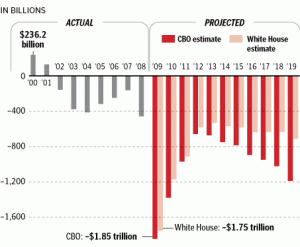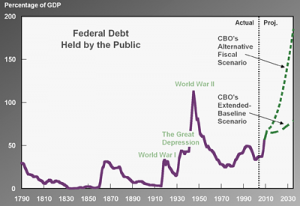The Congressional Budget Office is an independent non-partisan agency enacted by congress to help estimate the effect of laws on national revenue, review the budget process, and help make projections on the national debt. Earlier this week the CBO released their economic and budget issue brief, Federal Debt and the Risk of a Fiscal Crisis , and the Monster in the Attic fears were stirred in me all over again. U.S. government debt has grown so rapidly lately that it is projected to exceed the highest previous debt spiral in our history, the costs of World War Two, and proceed into territory considered by the CBO to be “unsupportable”. It is not clear what the fiscal crisis would look like if the United States, the primary economic engine in the world, were to face unsupportable economic choices, but it wouldn’t likely be anything the world would want to experience.
The economic consequences of an significantly growing debt to a nation in proportion to its gross domestic product creates typical economic responses learned in Economics 101. To pay for the debt, a growing portion of peoples savings would be diverted from personal investment in productive capital goods like consumer products or building factories. The reduced investment leads to lower economic output and therefore lower incomes. The increased levy of the government to pay for the debt requires higher marginal tax rates, further discouraging work and savings and further reducing output. The circular spiral to resultant lower available money to pay for the debt at the very time when the increasing debt demands more input leads to the need for other sources of income to pay for current programs or prevent collapse – printing more money inciting inflationary pressures, or borrowing from foreign sources increasing the long term indebtedness.
The ability for the government to borrow is predicated on the government investor’s willingness to trust that government’s ability to pay back the owed money. What happens if in difficult times, a fiscal crisis occurs where investors would lose confidence abruptly and either no longer lend or lend at a significantly higher interest? We don’t have to look far for an example – within the last twelve months the world wide recession drove Greece, a nation with a debt greater tha 110% of its gross domestic product into default, as the investors in that debt simply refused to put any more money down the black hole. An emergency fund by the European Union , of which Greece is a part, decided to staunch the bleeding temporarily and painfully lend Greece two hundred billion dollars to prevent the complete collapse of governmental services and secondarily debt payment. There is no indication this one time buttressing will prevent the progression of Greece’s debt crisis and its eventual default. Greece has a current GDP of 343 billion dollars and is the 27th largest economy in the world. What would happen if the United States, the number one economy in the world, with a GDP of 14 .5 Trillion dollars, would find itself needing to finance a similar debt?
As seen in the CBO figure below the Federal Debt held by the public since 1790 has varied, driven high particularly by crises such as depression or war, but has been driven back by the vibrant health of the American economic engine. As recently as 2007, the percentage of debt to GDP stood at 36%. The deep recession and massive government investments like TARP, Auto industry Bailouts, and Stimulus packages, have driven the percentage to 62%, a level not seen since World War II. What particularly worries the CBO is the unbridled goals of further government investments over the next twenty years, such as entitlement expansion that remain unfunded. Without changes in fiscal policy, the CBO predicts the debt held by the U.S. public to exceed 110% by 2025, 180% by 2035. Within most of our lifetimes we will see the United States facing the current choices held by Greece. Who may I ask, will be our European Union to bail us out?
As the CBO simply states, the higher the debt, the greater the risk of a financial crisis. The process is fairly straight forward; the government’s all consuming appetite is driving it to seek more foreign investment to support its growing debt. Currently over 4 Trillion of the debt is owned by foreign investors, 1.7 Trillion by China and Japan alone. Any further economic downturn by the world’s greatest consumer nation would significantly effect the very countries who are the suppliers of much of those consumer goods, effecting their bottom line and eroding their further ability to underwrite our financial needs. The U.S. government would be left with very poor choices – restructuring the debt thereby even further burdening later generations, or printing money and driving inflation. The expected interest payments of the U.S. government annually to creditors expected by 2015 is 460 Billion, not taking into account interest hikes or further spending. The CBO predicts a simple 1 percent increase in inflation over the next decade would drive budget deficits 700 Billion dollars higher. Now we are clearly getting into that unsustainable range.

The solution? No matter what, the CBO says a combination of spending cuts and revenue increases adding to 5% of GDP is necessary to prevent an increase in the US debt to GEP ratio over the next 25 years, the equivalent of 20% of this year’s non-interest spending in the current budget year. Ouch!! That should convince anybody of the pain ahead and the need to get serious in holding our government leaders accountable for their desires to feed the problem, rather than solve it. Times a-wasting, people. 2010 is as good a time to start as any.

War or tax cuts. One or the other.
Wars are expensive. They “tax” a nations financial resources. If a nation would like to fund a war effort, then do so by continuing to balance the budget during the war or immediately after. Wars are literally hostile takeovers. A war boils down to one question:
“Who can produce the most goods in the shortest amount of time to support their side of the effort?”
The United States prevailed in WWII because we had “Rosie the Riveter” supplying the front lines with ammunition, arms, tanks, planes, carriers and every other armament to defeat the Axis Powers. Civilians in the States were aware of sacrifices that had to be made and rationed out food so the soldiers would have what they required. Victory Farms were everywhere. We simply outproduced the other sides in materials and soldiers. It certainly helped that the support of the world was on the side of the Allies. To be sure, if there was ever a just cause and a just war, WWII was that time.
The books were mostly balanced and after the war, the United States was properly tooled to supply the world with all of the manufacturing it could handle, so any excess debt was paid down shortly after the war was over. The Baby Boom began because it was a safe world and everybody had money to buy the American Dream.
Present Day. It has been 60 years since the United States economy began its dominance of the world stage. 60 years. Very few of our current leaders were around to understand hardship. They are not aware of what sacrifice is. Our leaders are the product of a society in which they were left never wanting but always having a better life. It stands to reason they should want to give everybody all of the advantages they had. Unfortunately for many citizens, work is still required, and that price of admission is simply too high for many. One of the Founders stated, “I find the harder I work, the more luck I have.”
On a side note: It is sad that most don’t see the bigger picture in the border battle taking place in Arizona. Despite all of the shortcomings in our nation, people are still literally dying to cross the border because they know a better life lies on the other side. Not to necessarily simply take advantage of our welfare state (that’s a bigger problem with third and fourth generations). These people simply want to work for an honest days wage and know that they will be safe in their homes at night. Simple desires, really. The immigrants need to “sign the book” on the way through and the government needs to make the book more accessible. Let’s be honest here; a very small percentage of the population actually has a claim to the land we stand on. Let’s not be jerks about keeping people out of the party we crashed.
This nation guarantees every American the ability to achieve the American Dream (life, liberty and the pursuit of happiness). It does not simply guarantee every American the American Dream. The first generation immigrants into this country are proof that our experiment is alive and well. We all know the guy behind the counter at a great restaurant with the thick accent or the electrician that doesn’t understand a word you’re saying, but understands how to make your lights work better than anybody else around. They work hard because they don’t want to be intrusive guests. These people want to pay their way.
The economic situation is simple. If Congress and the President believe the war is a just cause and worth continuing, then raise taxes to pay for the effort. If not, end the war and taxes will still need to be raised for a time. If the economy is worth $14 T, then I would guess a 5 year period of an elevated tax rate (and some serious entitlement gutting) to bring the budget back into a manageable balance would be in order. Better to lose 5 years of growth than to lose our safe haven.